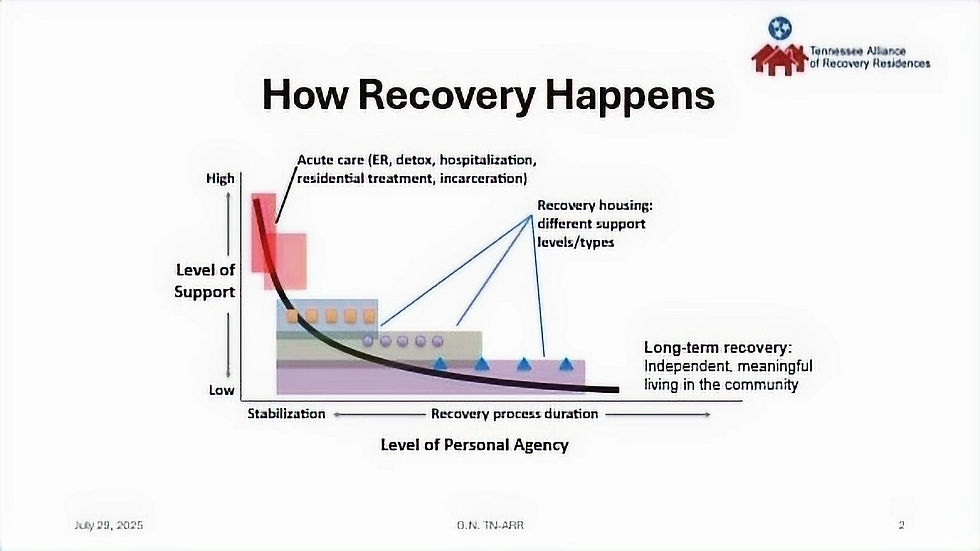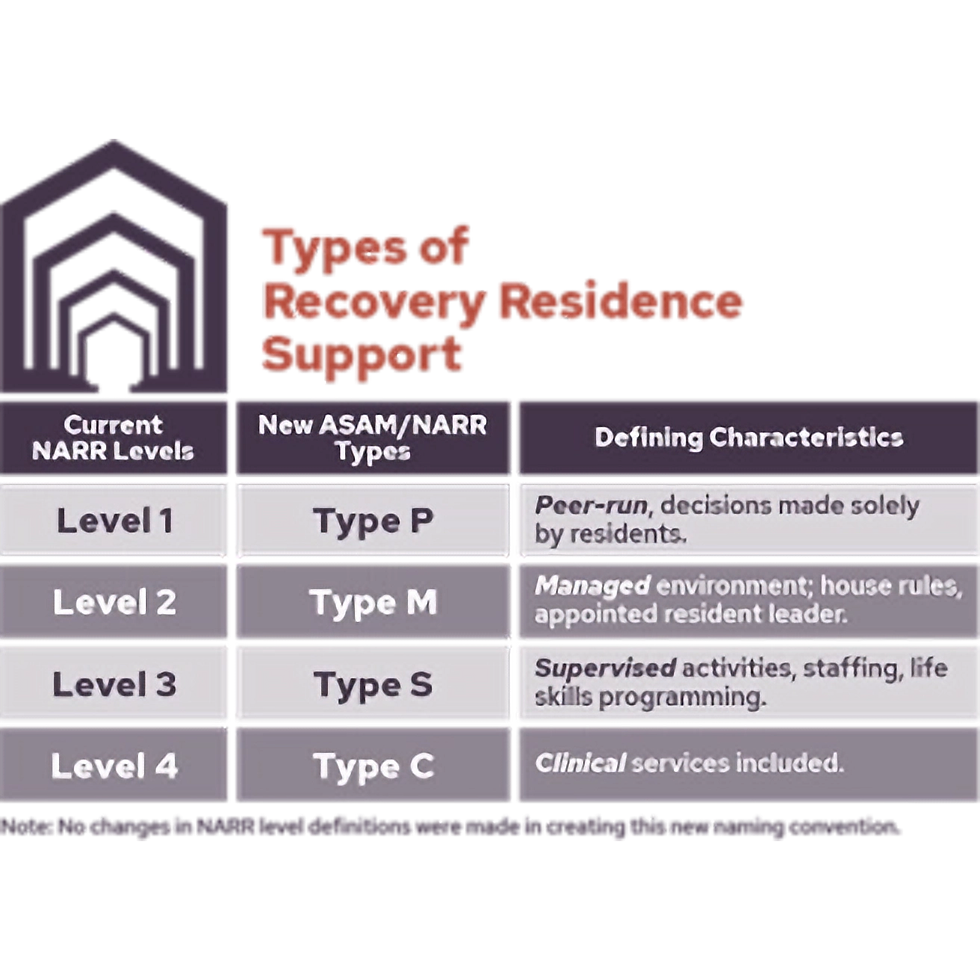Addiction vs. Agency: When Can a Recovering Person Safely Make a Choice?
- Garrison Nuckols

- Aug 22
- 6 min read
Updated: Aug 23
It’s two in the morning. A man sits in dark room with a bottle in one hand and a cell phone in the other. The room carries a dim glow as he peruses Instagram. “What the hell, they bought a house and they’re having a kid?!” He had just moved back into his parents’ house at the age of 29 – logistically the furthest point from ‘starting a family’ his mind could imagine. “Fools. If they knew what I know, they’d never bring kids into this world,” he murmured as he scrambled to find moral high ground and took another gulp.
This is what end-term addiction looks like. An individual totally isolated and equally addicted to substance and blame. Some arrive here after years of “having fun” and others by way of trauma and self-medication. Regardless of the path, once each individual crosses their individual, genetic line in the sand – they are addicted. This simply means that the body chemistry has shifted to become dependent on the presence of a mind-altering substance.
The human body is intelligent. When it needs something, it finds a way to communicate that to us. If it is dehydrated – we feel thirsty, or if there is an injury that needs stillness to heal – there is pain with movement. In the same way, if the body becomes addicted to a substance, it simply inflates the ego (sense of self) to remove perceived choice from the addicted individual. This authoritarian takeover leaves the person in a habitual state of victim-hood, fight-or-flight and “having to use.” This hijacking of the frontal lobe (decision center of the brain) eventually erodes all personal agency or “ability to make a safe choice.”
At this stage, most individuals cannot stop even though they want to “choose recovery.” Many require structured separation from the substance through medical detoxification, residential stabilization or inpatient treatment. It’s at this initial point of the recovery journey that we can begin to observe the inverse relationship between personal agency and necessary support. When a person has very little personal agency they require a high level of support. Parenthetically, as they traverse through their recovery process and regain personal agency, their necessary level of support will decrease proportionately. Please refer to the following graph for a visual representation of this relationship:

We can observe that at the conclusion of initial stabilization or “treatment” (usually between 30 and 90 days), personal agency is still highly diminished. Unfortunately, many individuals leave supportive environments at this stage resulting in a high rate of recurrence (return to use), need for re-stabilization and, in some cases, death. While longer stays in a highly structured environment might seem like a remedy, too much support can continue to cause atrophy to personal agency and leave individuals institutionalized or in habitual need of a highly structured environment to function. Alternatively, at this point we also see the opportunity for recovery housing (abstinence-based supportive housing) to fill the void and offer necessary support until an autonomous level of personal agency returns.
Unfortunately, all recovery homes are not created equally. During the fragile season of early recovery, the fraction of recovering individuals who understand that their ability to make safe choices has been compromised rely fully upon the ethical suggestions from those around them. Here, many devote themselves to providing safe, ethically operated recovery homes while others only see an opportunity for financial incentive and leverage. This discrepancy clearly demonstrates why accountability is so crucial for the providers of these services.
Enter the National Alliance for Recovery Residences (NARR). This national standards body combines decades of cumulative recovery housing experience into the only widely, nationally accepted best practices, standards and ethics in recovery housing. NARR authorizes individual state affiliates (such as TN-ARR, Tennessee’s NARR Affiliate) to certify recovery housing environments within that state who choose to adopt these best practices, standards and ethics. These organizations are categorized based on the level of support they provide their residents which correspond with the American Society of Addiction Medicine (ASAM) continuum of care model. Reference the following graphic for details:

All homes certified by the NARR standard operate through a framework known as the Social-Experiential Model of Recovery. This person-centered, peer-driven philosophy is specifically designed to allow recovering individuals to regain their personal agency at their own pace. Knowing that that the body communicates addiction through ego and victim-hood, the SEM (Social-Experiential Model) focuses on supporting each individual’s choices and utilizing the wisdom of the group. By focusing on empowerment rather than compliance, certified homes put each person in charge of their recovery, not the other way around.
A foundational SEM approach is the use of personal agreements (such as “I commit to..”) instead of rules. Where ‘house rules’ invite punishments, personal agreements invite conversation and growth opportunities. Let’s use curfew as an example for what might appear on a recovery home’s entrance paperwork:
Sober Living that operates with rules
“Your curfew is 10pm. If you are late you get a strike, if you get three strikes you are kicked out”
First, let’s acknowledge that this can be written by someone who only wants to help. They may subscribe to the “If you want it bad enough, you’ll do it” bootstraps mentality. While this approach works well in some areas of life, it often only causes harm to people trying to regain personal agency and directly feeds into the pathway of victim-hood. This authoritarian model chooses for the recovering person, robbing their ability to grow. That’s not to say that a home cannot stay in business operating this way. However, if a person complies for a month, a year or decade, they will transition out of the environment with the same amount of personal agency they came with. This results in high levels of recurrence after exiting the environment. Not only does this take people back to square one, but it actively harms them by making them believe they are “defective,” a “chronic relapser” or “just can’t get it.” Furthermore, if there is a trauma present directing their behavior, there is no pathway to help uncover that. This philosophy leads many recovering people to additional suffering by not allowing them to choose their own recovery path. Intentionally or not, they get ‘set up’ by someone who thought they were helping.
Certified Recovery Home that operates with the SEM
“I understand that my curfew is 10pm and commit to being home before that time. I also understand that support is available if I experience challenges upholding my commitment.”
Immediately we notice a stark difference in tone. Instead of seeking compliance, this agreement is asking to partner with each individual in their personal journey. Focusing on the individual’s commitment creates an opportunity for their personal agency to grow. When someone upholds their agreement, they go to bed knowing they did what they said they were going to do that day – this is monumental for a person who feels like they can’t trust their own discernment. Alternatively, if a person is unable to uphold their commitment, there is an opportunity for the operator to facilitate conversation with the individual and their housemates to understand what is more important to them than having a safe place to live (see Maslow’s Hierarchy). Here other people in early recovery can offer suggestions and feel useful. Often this conversation can lead to uncovering deeply held beliefs (some caused by trauma) of unworthiness that fuel self-sabotaging behavior. This is Jungian shadow integration in practice. Here we see the true power of the SEM – being able to take something as trivial as a curfew and optimize it to change the trajectory of a person’s life while creating a gift-economy that allows everyone involved to benefit.
By focusing on allowing the group to support each of its members, the operator is removed from an authority position. This goes directly against the us vs. them addiction mindset and allows the operator to serve as a support for recovery home rather than be the ruler of it. Then, with support, each certified recovery home can traverse their recovery journey together. This is how people grow and change their lives – empowerment.
When can a recovering person safely make a choice? The truth is, we all need support. Being a part of a community is in human DNA. Addiction constantly pushes people into isolation and certified recovery homes offer a tangible pathway back to connection. The adage, “The opposite of addiction isn’t abstinence, the opposite of addiction is community” didn’t receive notoriety by accident. It’s the truth. The SEM supports each person as they progress through recovery with peer support, and when ready – they can transition to the next phase of their recovery with connections they can keep. Some return to independent living within a year. Others, like the individual in the introduction, stay for a few years and then transition into providing this life-saving service to others and writing articles like this.
Addiction is authoritarian, TN-ARR certified recovery homes are empowering.
Garrison Nuckols
Lived Experience Professional
Director of Operations
Tennessee Alliance of Recovery Residences
Owner/Founder
Mountain Pass Recovery - Certified Level 3 Recovery Community




Comments